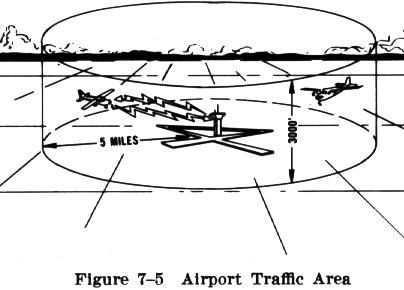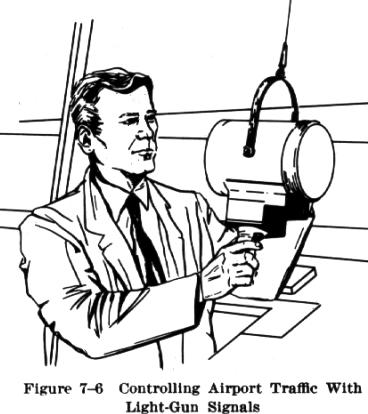
| Not all airports have control towers, but it is essential that the pilot become familiar with the requirements and procedures where a control tower is used. Today's airport congestion resulted in the "airport traffic area" concept of traffic control for those airports that have a control tower in operation. Where an airport traffic area exists, it extends to a radius of 5 statute miles from the center of the airport, and extends up to (but not including) 3,000 feet above the airport surface (Fig. 7-5). Airport traffic areas are not depicted on aeronautical charts, but the airports at which these areas exist are identifiable on the charts by a control tower radio frequency and the letter CT adjacent to the airport symbol. Complete radio data for each airport having radio communication facilities is found in the Airport/Facility Directory |
 |
When operating at an airport where traffic control is being exercised by a federally operated control tower, pilots are required to maintain two way radio communication with the tower while within the airport traffic area, unless the tower authorizes otherwise. Through this communication the pilot requests permission from the tower operator to taxi, take off, or land and receives a specific clearance along with pertinent information about the traffic pattern.
The tower controller will issue clearances (instructions)
for aircraft to generally follow the desired flightpath (traffic pattern),
as well as the proper taxi routes when operating on the ground. If not
otherwise authorized or directed by the tower, pilots approaching to land
must circle the airport to the left. However, an appropriate clearance
must be received from the tower before the landing may be made.
 |
Airport traffic control is based upon observed, or reported known traffic,
and airport conditions. Tower controllers establish the sequence of arriving
and departing aircraft by requiring pilots to adjust their flightpaths
and speeds as necessary to achieve proper spacing. These adjustments can
only be based on observed air traffic, accurate position reports from pilots,
and anticipated aircraft maneuvers.
On occasion it may be necessary for a pilot to maneuver the aircraft to maintain spacing with other traffic. The controller can anticipate minor maneuvering such as shallow "S" turns. The controller cannot, however, anticipate a major maneuver such as a 360 degree turn. If a pilot makes a 360 degree turn after obtaining a landing sequence, the result is usually a gap in the landing interval and more importantly, it causes a chain reaction which may result in a conflict with following air traffic, and interruption of the sequence established by the tower or approach controller. Should a pilot decide to make maneuvering turns to maintain spacing behind a preceding aircraft, it is necessary to advise the controller. Except when requested by the controller or in emergency situations, or when receiving radar service, a 360 degree turn should never be executed in the traffic pattern without first advising the controller. |
Procedures in which light gun signals are used apply only when the aircraft using the particular airport is not equipped with two way radio, or when radio contact cannot be established or maintained (Figs. 7-6 and 7-7).
In addition to directing all incoming and outgoing air traffic by radiotelephone or light gun signals, the tower also provides current weather data, altimeter setting, and any other information necessary to safe flight within the airport traffic area.
--------------------------------------------------------------------
COLOR AND TYPE : AIRCRAFT ON THE GROUND
: AIRCRAFT IN FLIGHT
OF SIGNAL :
:
--------------------------------------------------------------------
Steady green : Cleared for takeoff
: Cleared to land
--------------------------------------------------------------------
Flashing green : Cleared to taxi
: Return for landing
:
: (to be followed by
:
: steady green at
:
: proper time).
--------------------------------------------------------------------
Steady red : Stop
: Give way to other
:
: aircraft and
:
: continue circling.
--------------------------------------------------------------------
Flashing red : Taxi clear of landing
: Airport unsafe -
: area (runway) in use : do not land.
--------------------------------------------------------------------
Flashing white : Return to starting point
:
: on airport
:
--------------------------------------------------------------------
Alternating red : General warning signal
: exercise extreme
and green :
: caution.
--------------------------------------------------------------------
Figure 7-7 Meanings of Light Gun Signals
Tower operators are all licensed by the FAA, and the towers themselves are in most cases under the jurisdiction of the FAA, although some are independently run by the individual airport operator. If the tower is not Federally operated, communications are required if the aircraft is equipped with radio. If the aircraft's radio allows only reception from the tower, a listening watch should be maintained.